What is Buta Kimchi Itame?
Buta kimchi itame (豚キムチ炒め) is a well-loved Japanese stir fry dish based on a Korean dish called “Dwaejigogi-bokkeum”. In Japanese, buta means pork, kimuchi means kimchi, and itame means stir fry. So, it is a general term for stir-fried dishes using pork and kimchi, including other vegetables and other ingredients.
As you can probably guess, the Japanese version is not so spicy. I’d say this dish is quite similar to “Shogayaki” ginger pork, but flavored with kimchi instead.
The thinly sliced pork is lightly coated in flour and fried to make it golden and lightly crispy, and then onions and kimchi are added to the pan and fried. I’ve added a few extra seasonings to make it special, but this recipe only requires a few ingredients. It’s so easy and quick, perfect for a mid-week dinner!
This dish is usually served as a main dish with freshly cooked Japanese-style rice, but it can also be enjoyed in smaller portions as a side dish.
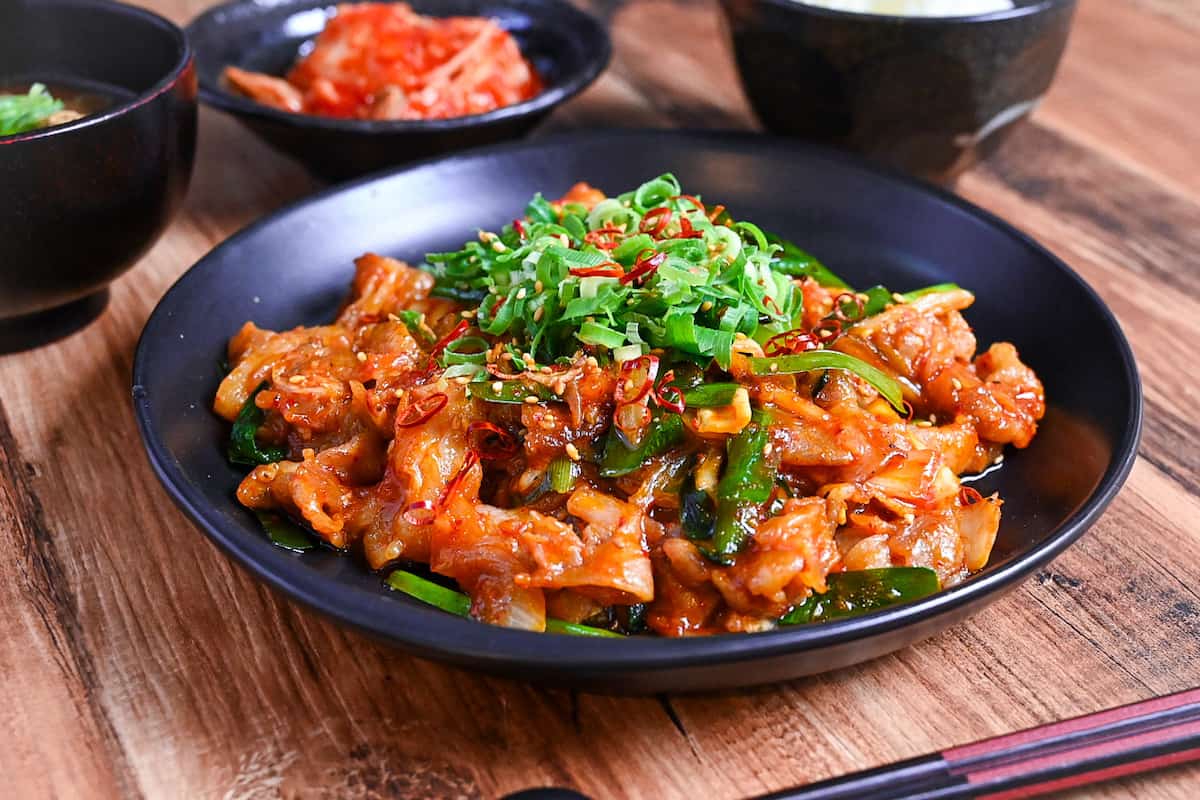
What Kind of Kimchi to Use for This Recipe?
At the heart of the recipe lies the star ingredient: Kimchi! This renowned spicy pickled delicacy hails from Korea and has garnered global fame. The most common variant is made from napa cabbage. However, you can also find intriguing twists such as radish and cucumber.
Kimchi’s popularity extends to Japan, where the fondness for pickles is nearly universal. For my Buta Kimuchi recipe, I recommend a slightly sweet, cabbage-based kimchi. But remember, the world of kimchi is as diverse as it is delicious, showcasing a range of spice levels, sweetness, and tanginess.
My palate leans towards a kimchi that’s both spicy and slightly tart, but ultimately, your choice should cater to your own flavor preferences. After all, it’s the primary flavor driver in this recipe. Always taste your kimchi before incorporating it into your dish. It’s a simple step that can save you from a regrettable result.
In this particular recipe, I’ve opted for a slightly sweet napa cabbage kimchi, a common and easily accessible choice that you can find in any Asian supermarket.
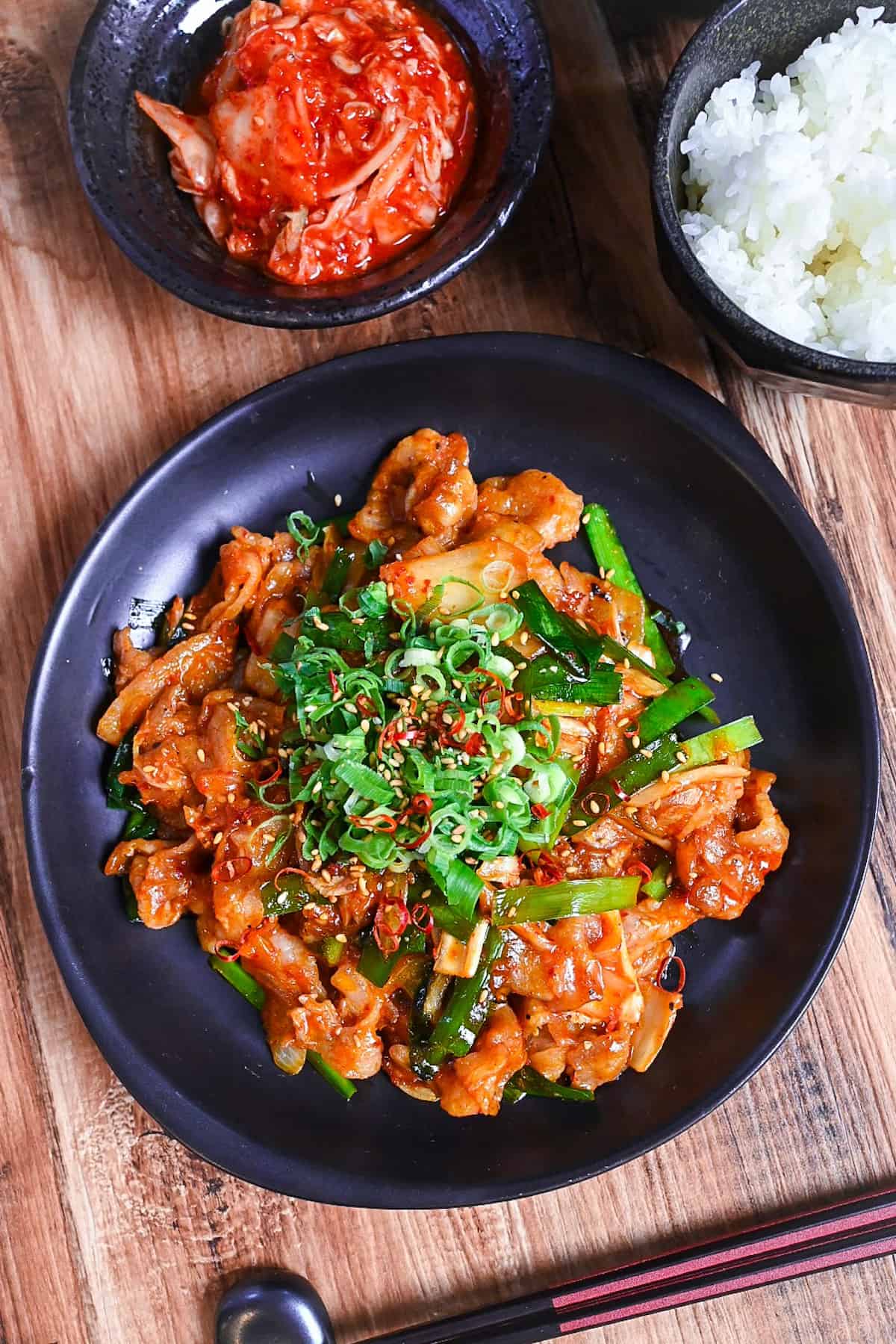
Ingredients & Substitution Ideas
- Thinly sliced pork belly – Other parts of the pork can be used, but I recommend pork belly the most. Also, if thin slices of pork are hard to come by, cutting a block of pork belly into thick slices also works great and gives the dish a meatier feel!
- Salt and pepper – You can use your usual salt and black pepper.
- Plain flour – To coat the pork and create a crispy surface. It also helps make the kimchi juices thick, glossy and stick better to the surface of the pork. I use cake flour, but all purpose works fine.
- Garlic – It is used finely diced but can be grated or crushed.
- Ginger – Again, I use finely diced fresh ginger but can it’s fine to use grated if you prefer.
- Yellow onion – Thinly sliced onions add depth and additional sweetness to the dish. In Japan, yellow onions are most common, but white onions can also be used.
- Oyster sauce – The addition of oyster sauce adds depth and umami.
- Cabbage kimchi – I used slightly sweet kimchi made with napa cabbage.
- Sugar – It can be made with white or brown sugar.
- Soy sauce – Use Japanese koikuchi (dark) soy sauce for added depth and savory flavor. Check out my Shoyu 101 post for more information about Japanese soy sauce and my favorite brands.
- Dashi granules – For a hint of added umami.
- Garlic chives – Adding it at the end brings a little extra flavor and color. If you cannot find it in your area, substitute it with regular chives.
- Toasted sesame seeds – This is used to garnish the dish but is optional.
- Finely chopped green onion – It adds the final touch.
- Sesame oil – It is used to add subtle fragrance at the end.
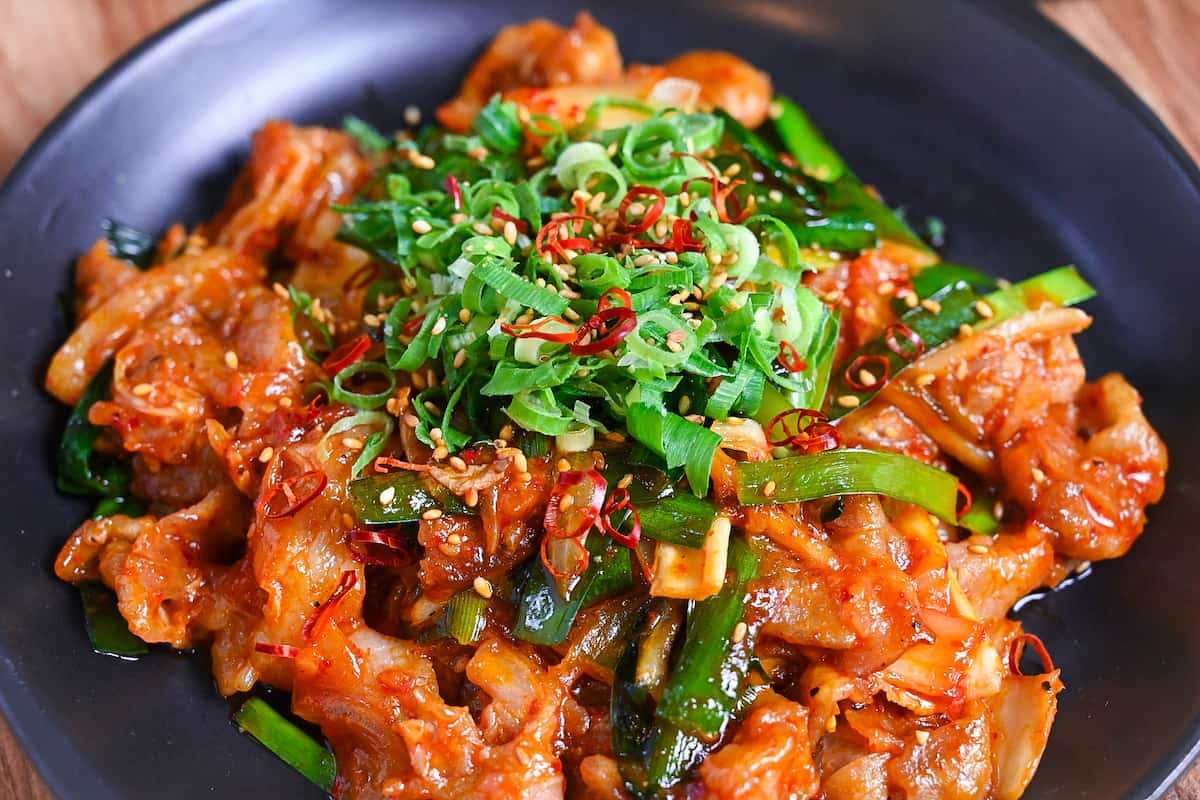
Visual Walkthrough & Tips
Here are my step-by-step instructions for how to make Buta Kimuchi Itame at home. For ingredient quantities and simplified instructions, scroll down for the Printable Recipe Card below.
Sprinkle the pork with a pinch of salt and pepper.
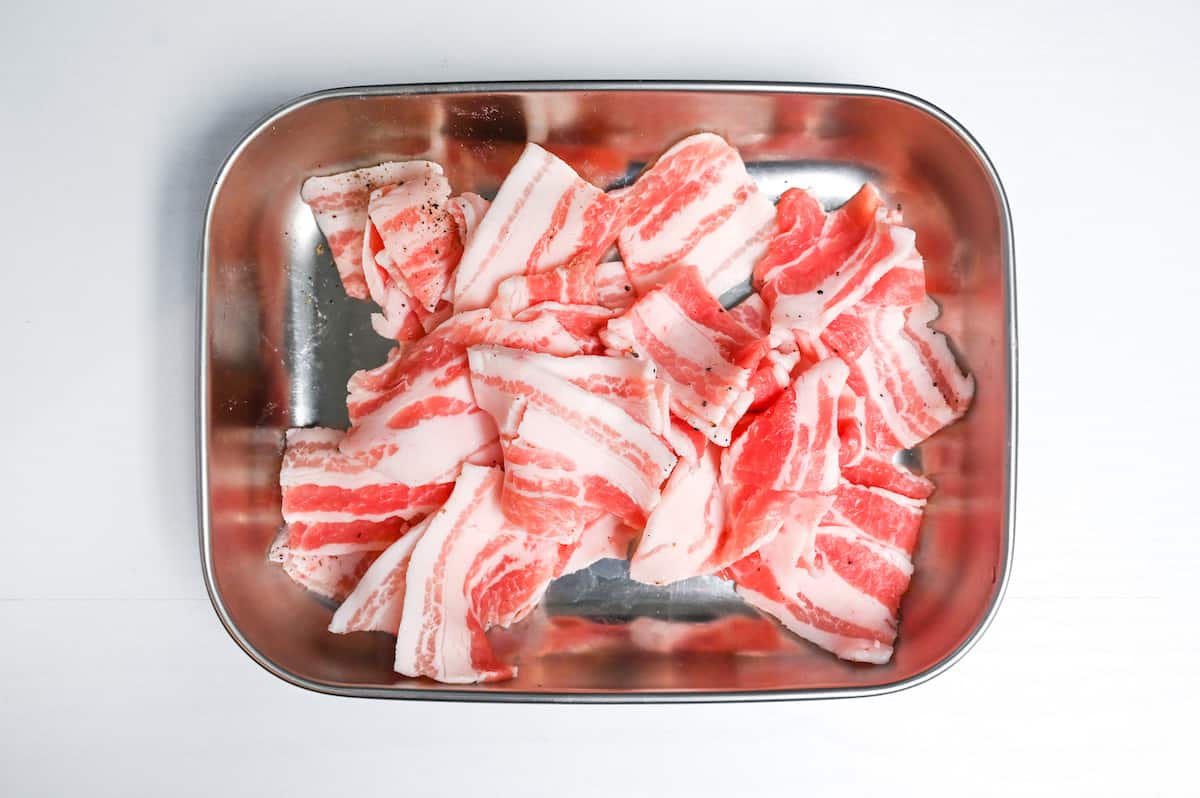
Coat with a thin even layer of flour. All-purpose flour or cake flour work best.
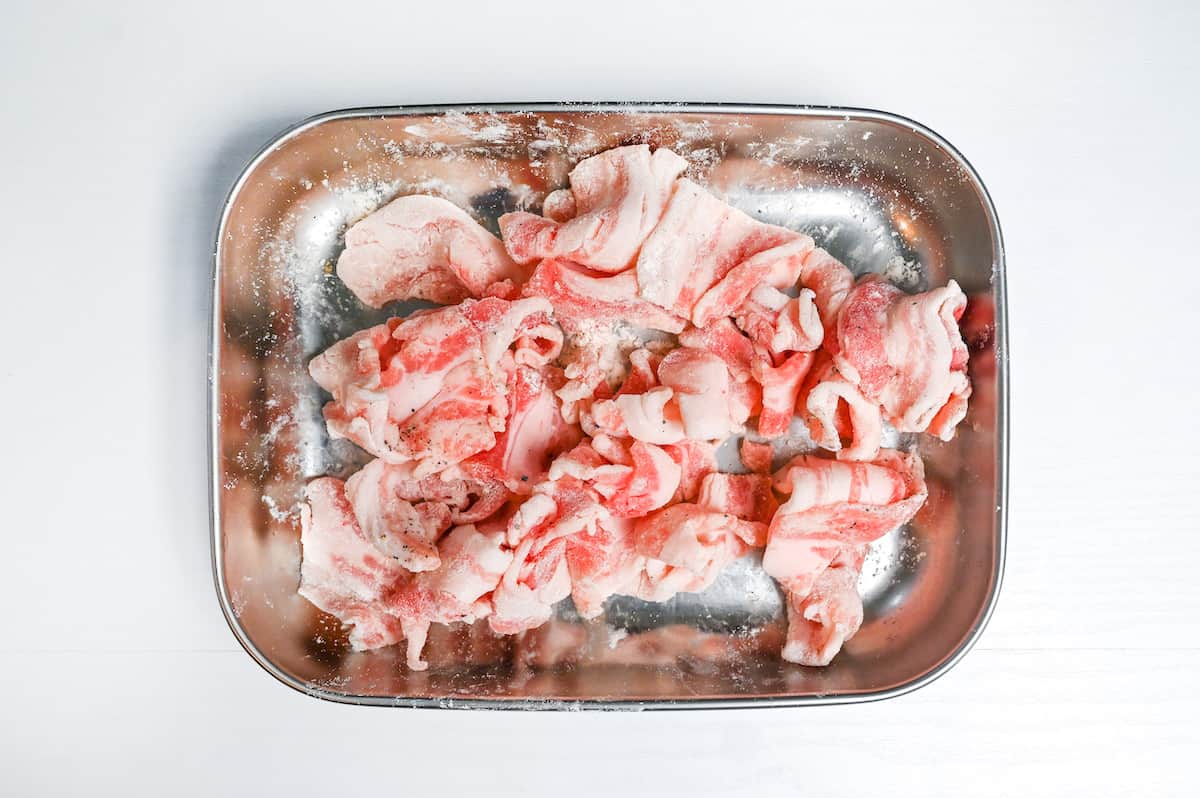
Heat a wok on medium and once hot, add cooking oil, finely chopped garlic and finely chopped ginger. Fry until fragrant.
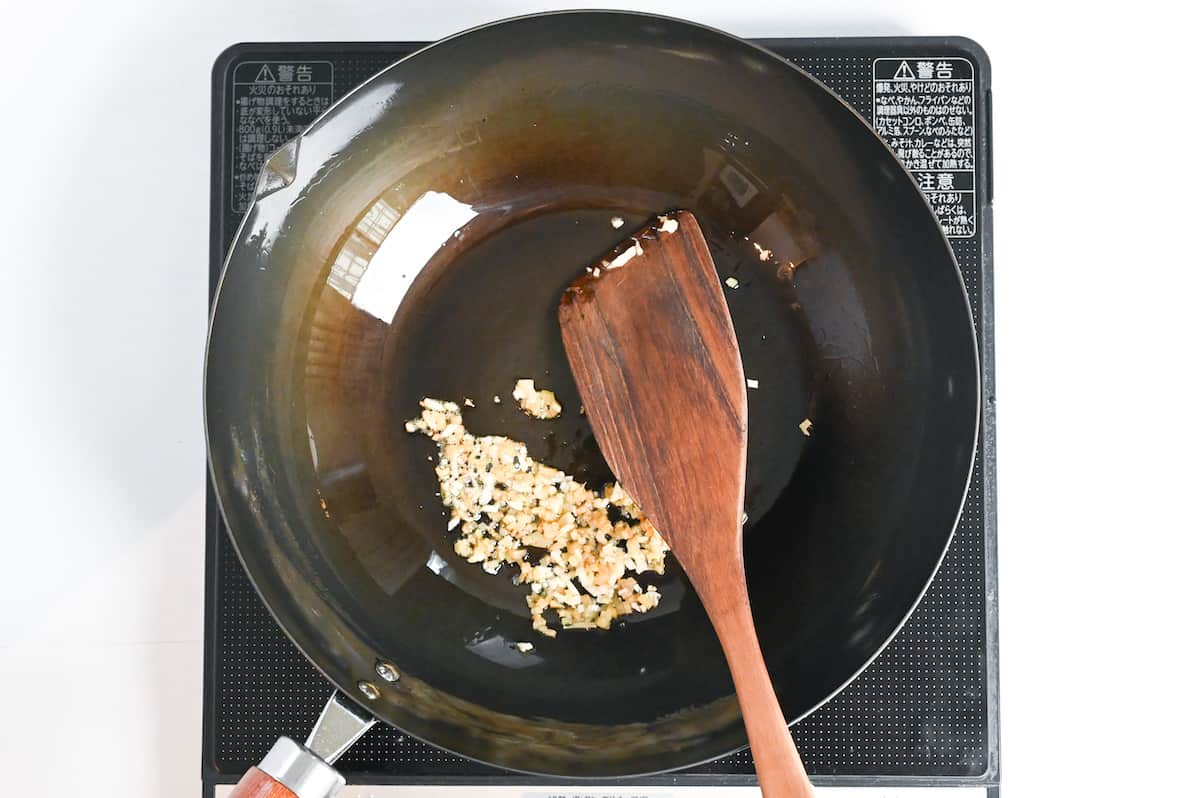
Add the pork to the wok.
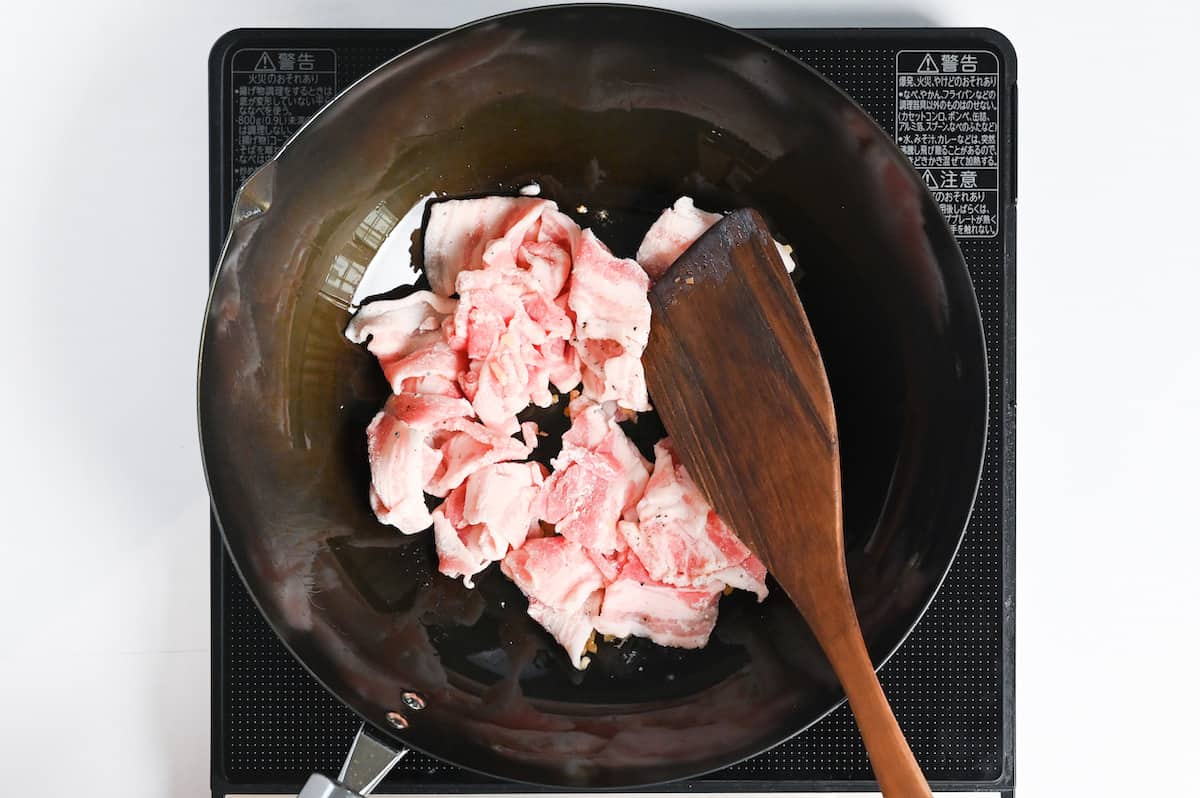
Fry until seared and the fat is slightly golden.
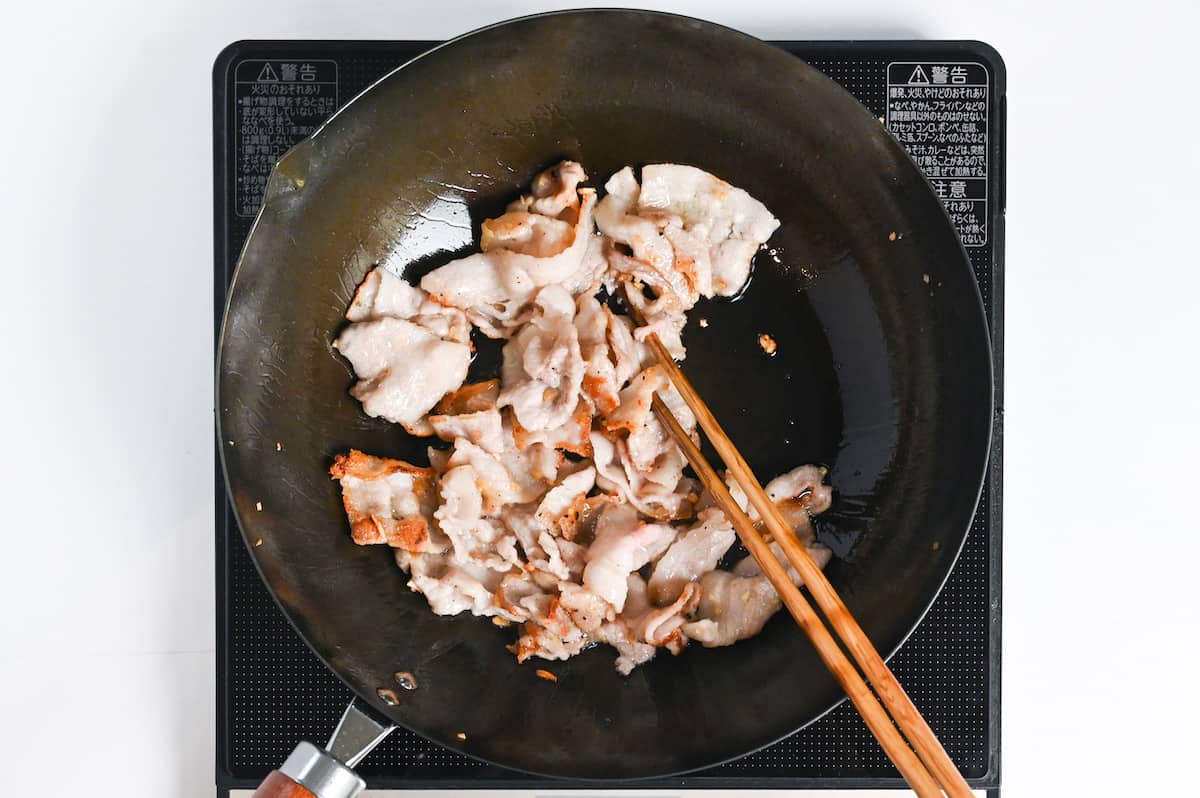
Add the onions to the wok and stir-fry until slightly softened.
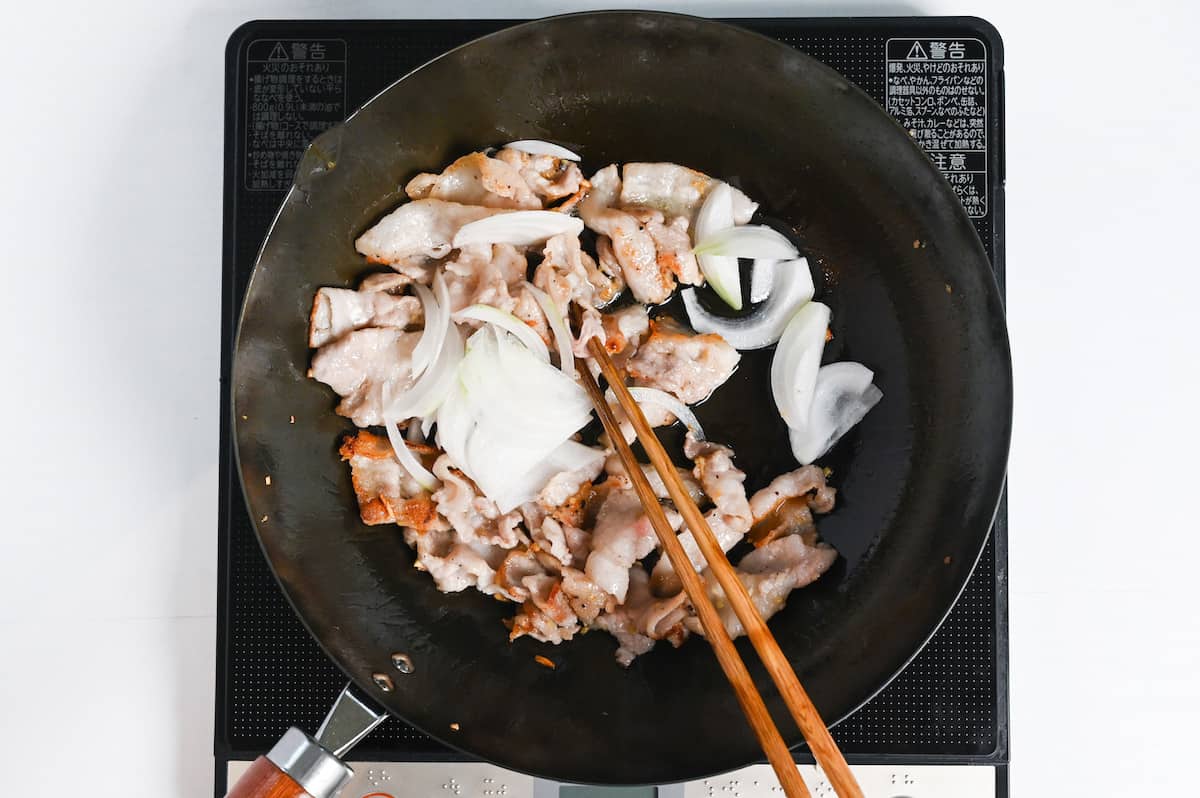
Add oyster sauce and kimchi to the wok (make sure to add all the juices from the kimchi too!).
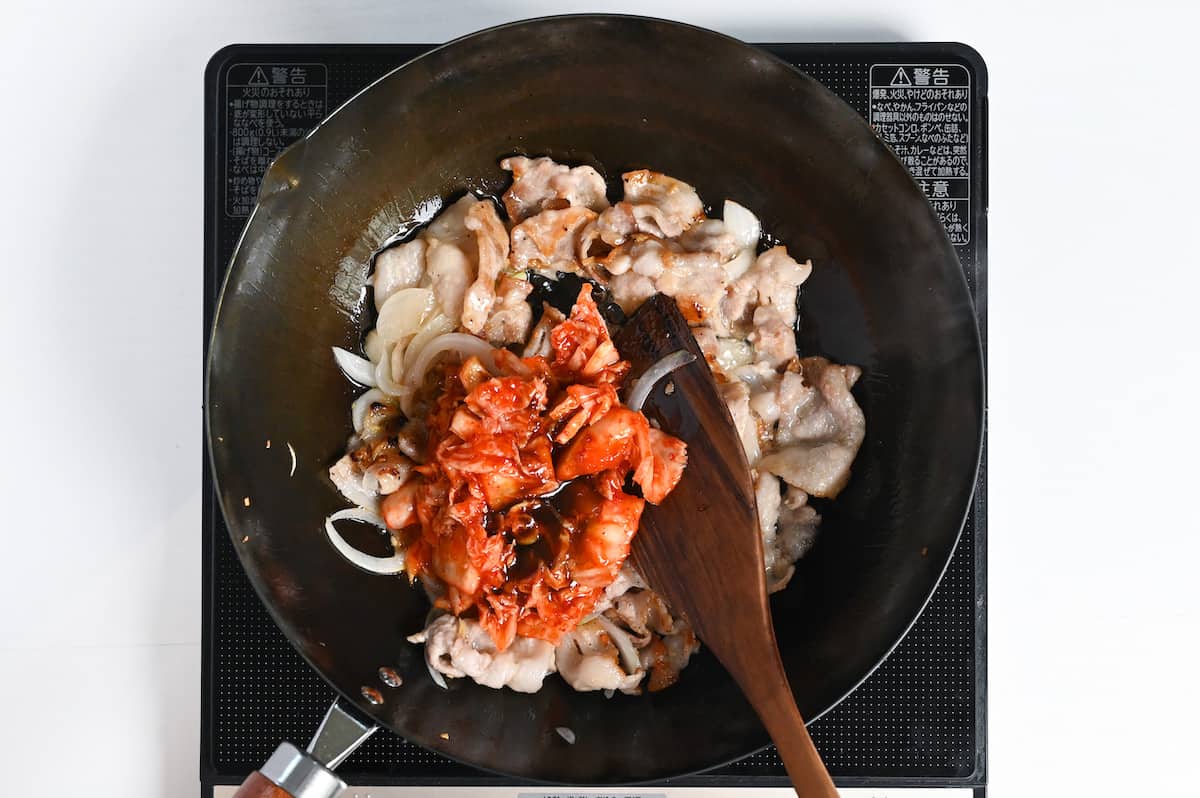
Add the sugar, soy sauce and a pinch of dashi granules and mix well. Continue to stir-fry until the kimchi is warmed through.
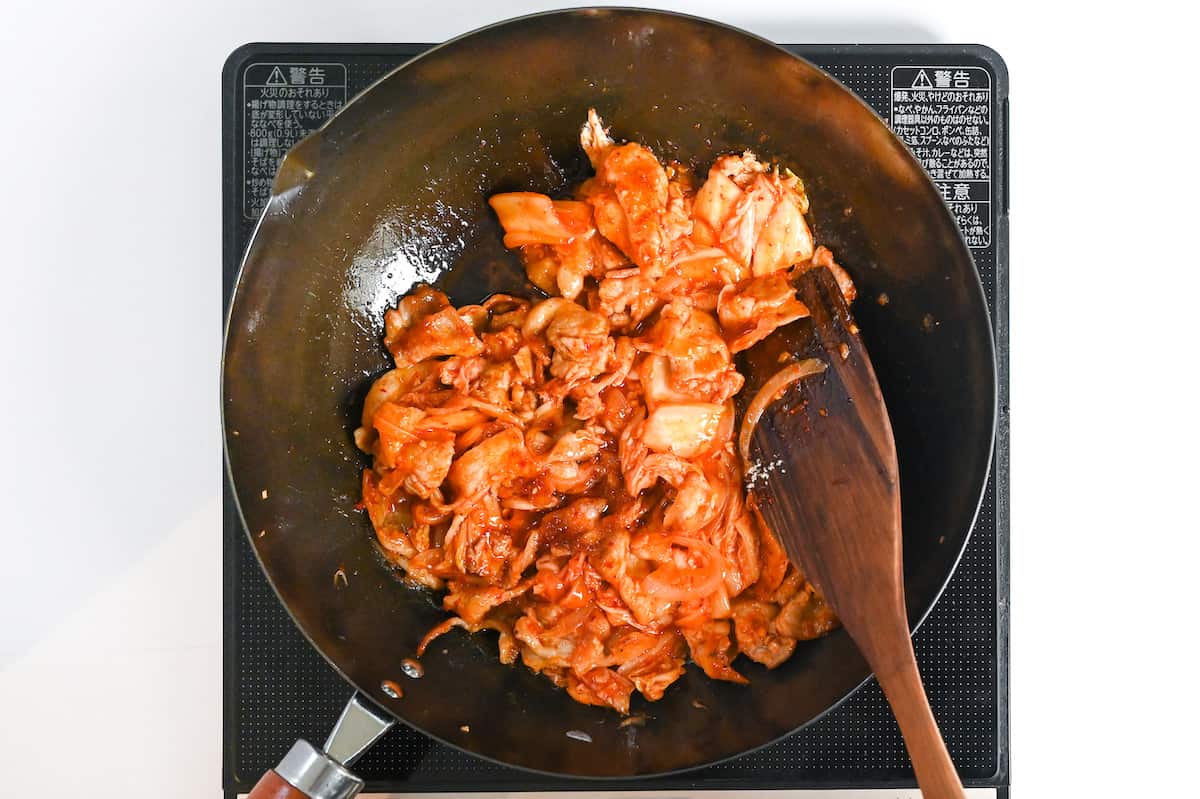
Add the garlic chives and stir-fry for one more minute before taking the wok off the heat.
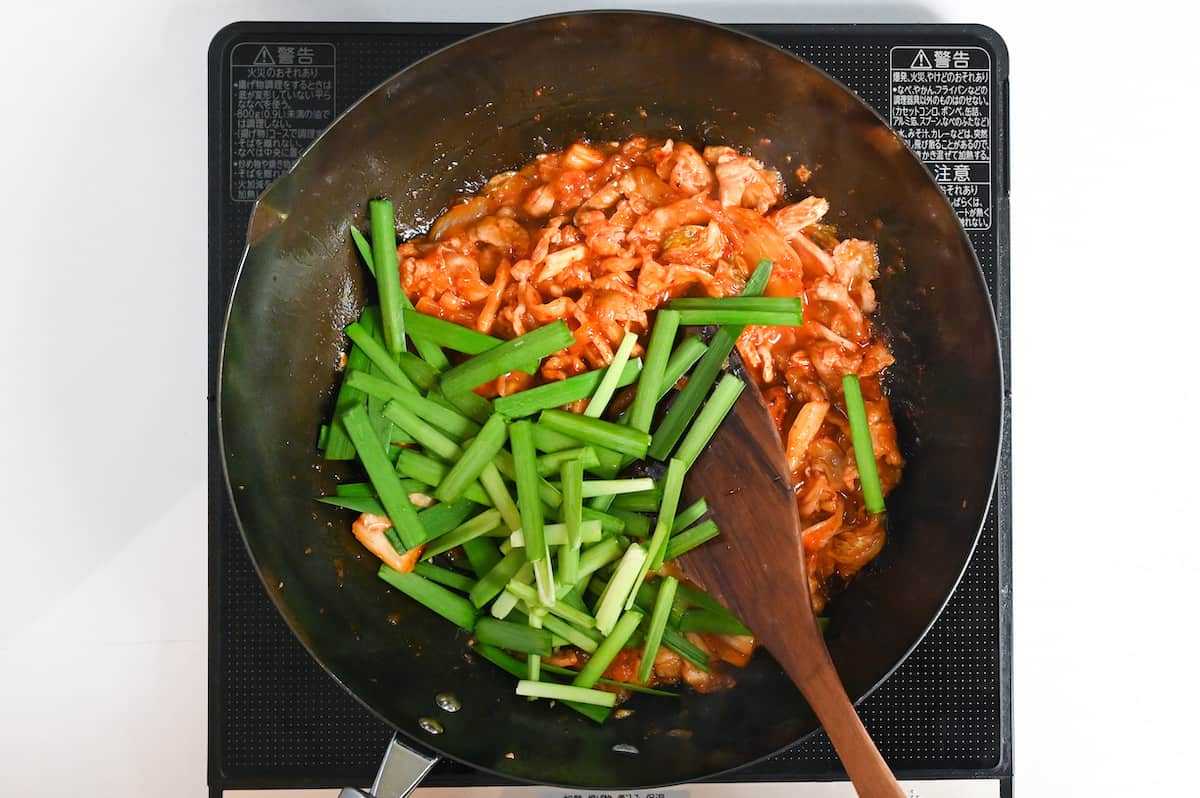
Transfer to a serving plate and top with toasted sesame seeds, a drizzle of sesame oil and finely chopped green onion.
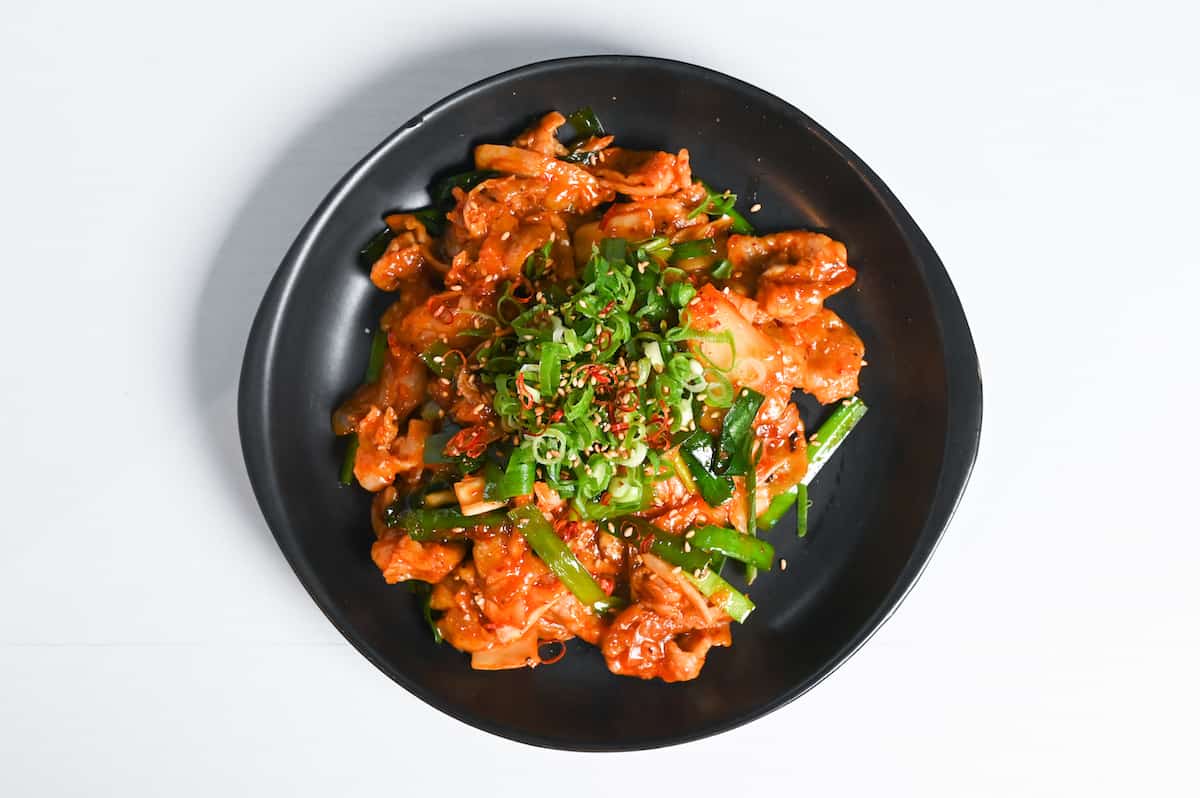
Enjoy!
Jump to Full Recipe MeasurementsHow to Store
Buta Kimchi Itame can be stored in two ways: refrigeration and freezing. Refrigerating the dish offers a short-term solution, retaining its optimum flavors for approximately 2 to 3 days.
For more extended preservation, freezing is the recommended method. If you make a big portion of buta kimchi, portion it into smaller, manageable portions before freezing for convenience.
Thaw slowly in the refrigerator and reheat either in a frying pan or microwave.
Storage summary
Room temperature – Not recommended.
Refrigerated – 2 to 3 days.
Frozen – Up to 1 month.
FAQ
Although there is no such thing as a Japanese version of kimchi, kimchi sold in Japan is often less spicy and sweeter than the authentic version.
Although it is not always necessary to stir-fry kimchi, stir-frying it with pork not only gives the pork the flavor of kimchi, but kimchi also has the property of reducing its acidity when heated.
While kimchi is mostly made with vegetables such as Napa cabbage and flavorings such as salt, chili peppers, and garlic, it can sometimes be made with fermented seafood as well. Ingredients depend on the brand.
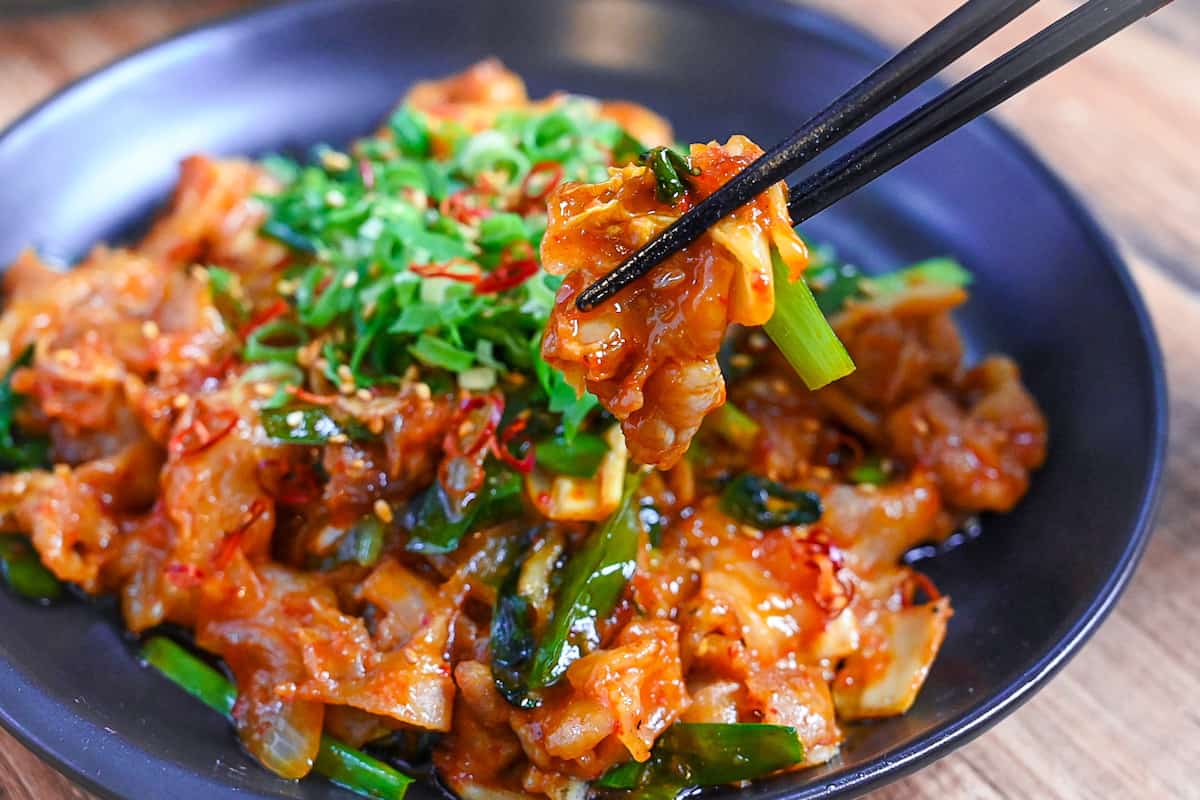
I hope you enjoy this Buta Kimuchi Itame recipe! If you try it out, I’d really appreciate it if you could spare a moment to let me know what you thought by giving a review and star rating in the comments below. It’s also helpful to share any adjustments you made to the recipe with our other readers. Thank you!
More Stir-fry Recipes
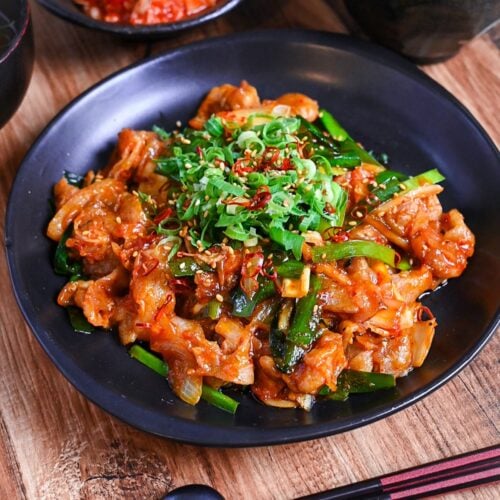
Buta Kimuchi Itame (Pork and Kimchi Stir Fry)
Ingredients
- 200 g thinly sliced pork belly
- 1 pinch salt and pepper
- 1 tbsp all-purpose flour
- ½ tbsp cooking oil
- 1 clove garlic finely diced
- 1 tsp ginger root finely diced
- ¼ onion sliced
- 1 tsp oyster sauce
- 200 g cabbage kimchi
- 1 tsp sugar
- ½ tsp Japanese soy sauce (koikuchi shoyu)
- 1 pinch dashi granules
- 30 g garlic chive(s)
- toasted white sesame seeds optional garnish
- finely chopped green onions optional garnish
- dried red chili pepper slices, optional garnish
- toasted sesame oil optional garnish
My recommended brands of ingredients and seasonings can be found in my Japanese pantry guide.
Can’t find certain Japanese ingredients? See my substitution guide here.
Instructions
- Start by sprinkling the surface of 200 g thinly sliced pork belly with 1 pinch salt and pepper, then lightly coat it with 1 tbsp all-purpose flour.

- Heat a frying pan on medium and once hot, add ½ tbsp cooking oil, 1 clove garlic and 1 tsp ginger root. Fry until fragrant.

- Add the pork to the pan and sear on both sides until the fat turns slightly crispy.

- Once browned, add ¼ onion to the pan and fry until it reaches your preferred firmness.

- Add 1 tsp oyster sauce and 200 g cabbage kimchi with all the juices.

- Mix well and add 1 tsp sugar, ½ tsp Japanese soy sauce (koikuchi shoyu) and 1 pinch dashi granules. Stir fry for a few minutes until the kimchi is heated through.

- Add 30 g garlic chive(s) to the pan and stir fry for another 1 minute.

- Dish up and sprinkle with toasted white sesame seeds, finely chopped green onions, dried red chili pepper and a drizzle of toasted sesame oil. Enjoy!





Absolutely delish!
Thank you, Esther!